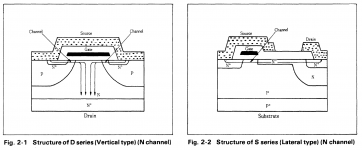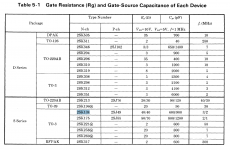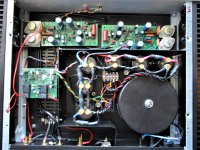Vertical mosfets arrived on the market in 1969-- I cannot expand your thumbnail but if the output mosfets are the original 2SK134/2SJ49 then they are vertical no matter how much Exicon advertise and promote their lateral mosfets as "replacements " .
Now I am totally confused ??
Please see this overview.
This doesn't appear to sink in probably because of the umpteen audio websites advising those posters who want to build actual JLH designed power amplifiers to use LATERAL mosfets .
As someone who not only bought every edition of EW/WW in that era including all John,s publications in other UK audio magazines including ETI-Today well know to UK electronics builders I completely fail to understand why after John made a big-big point of saying he used VERTICAL mosfets recommending Hitachi .
He said do NOT use Lateral as they require different conditions --it seems to be if you talk about something long enough everybody believes its "true" --except of course me who built all John,s designs and yes modified some at a later date .
I am at present trying to dig up the UK edition of the magazine he made this perfectly plain/clear in so to squash the mis-held believe that John used LATERAL mosfets in his designs in the 1980,s designs --he did not !
I wont be holding my breath as John,s designs have been copied worldwide and "modified " --never once have I used Lateral mosfets in them and yes --- I still have the original 1980,s VERTICAL mosfets used on his designs as well as a few spares from that era .
John also went to great length to show the superior audio quality of them but of course that "upset " D.Self who spent several editions of EW trying to rubbish them and promote his BJT output designs .
The same year, Hitachi introduced the LDMOS (lateral DMOS), a planar type of DMOS. Hitachi was the only LDMOS manufacturer between 1977 and 1983, during which time LDMOS was used in audio power amplifiers from manufacturers such as HH Electronics (V-series) and Ashly Audio, and were used for music and public address systems
2SJ49/2SK134
2SJ49/2SK134 are lateral mosfets according to Bob Cordell (Designing Audio Power Amplifiers, 2011, p.216)
"Lateral MOSFETs were the first to be applied to power amplifiers in widespread production,
perhaps the most well known being the Hafler MOSFET amplifiers [4], which
employed Hitachi lateral MOSFETs like the Hitachi 2SJ56/2SK176. Other popular lateral
MOSFETs included the Hitachi 2SJ49/2SK134 complementary pair [5]. Unfortunately,
these devices are no longer available."
2SJ49/2SK134 are lateral mosfets according to Bob Cordell (Designing Audio Power Amplifiers, 2011, p.216)
"Lateral MOSFETs were the first to be applied to power amplifiers in widespread production,
perhaps the most well known being the Hafler MOSFET amplifiers [4], which
employed Hitachi lateral MOSFETs like the Hitachi 2SJ56/2SK176. Other popular lateral
MOSFETs included the Hitachi 2SJ49/2SK134 complementary pair [5]. Unfortunately,
these devices are no longer available."
Dadod/Jaques --you do know D-MOSFETS are available in VERTICAL structure ?
The first D-Mos structures were lateral but were very large in size due to this , this brought about a change to a vertical structure called a "V-DMOS " so it was classed as vertical as its structure is vertical.
The first D-Mos structures were lateral but were very large in size due to this , this brought about a change to a vertical structure called a "V-DMOS " so it was classed as vertical as its structure is vertical.
I believe the D just means diffused channel. V-FETs have a V-shaped gate structure and vertical current flow. Power MOSFETs have vertical current flow these days, unless there's a reason to the contrary (typically when several MOSFETs are on the same die, such as in a motor-driver, class-D amp chip, etc). If all the power FETs on a chip have the same polarity and have drains in common, then vertical current flow is possible - however its unlikely to be the case in practice.
LDMOS means lateral current flow diffused channel, such as audio lateral FETs and microwave/RF amplifiers.
Incidentally online I found at least 3 different versions of the acronym "DMOS", diffused, double-diffused and discrete... The later is definitely incorrect as integrated MOSFETs are usually DMOS! There is some confusion in the nomenclature it seems.
LDMOS means lateral current flow diffused channel, such as audio lateral FETs and microwave/RF amplifiers.
Incidentally online I found at least 3 different versions of the acronym "DMOS", diffused, double-diffused and discrete... The later is definitely incorrect as integrated MOSFETs are usually DMOS! There is some confusion in the nomenclature it seems.
Dadod/Jaques --you do know D-MOSFETS are available in VERTICAL structure ?
The first D-Mos structures were lateral but were very large in size due to this , this brought about a change to a vertical structure called a "V-DMOS " so it was classed as vertical as its structure is vertical.
Those LDMOS or laterals where very popular in power amps becouse there is no thermal runaway caracteristic to vertical and hexfets. Tempco goes negative after quite low current normaly about 100 mA where for verticals it s after quite higher current.
Interesting discussion.
The important thing for me is that this is an excellent amplifier although it has been designed 40 years ago.
I have built more than 10 channels of this amplifier since the '80s and all of them sound excellent.
Four of them were built using the Exicon Mosfets and to my ears they sound a little more "transparent".
I have some PCBs if someone is interested to build this amplifier either with Hitachi Mosfets or Exicon Mosfets.
The price for a pair of PCBs is 34 Euros (shipping is including).
The important thing for me is that this is an excellent amplifier although it has been designed 40 years ago.
I have built more than 10 channels of this amplifier since the '80s and all of them sound excellent.
Four of them were built using the Exicon Mosfets and to my ears they sound a little more "transparent".
I have some PCBs if someone is interested to build this amplifier either with Hitachi Mosfets or Exicon Mosfets.
The price for a pair of PCBs is 34 Euros (shipping is including).
As not everyone agreed I was a bit confused between vertical and lateral mosfets.
Luckily it is all clearly explained in the 1985 Hitachi Power Mosfet Databook (link here).
In a nutshell:
D-series are vertical mosfets (e.g.2SK346-2SJ102)
S-series are lateral mosfets (e.g.2SK134-2SJ49)
See attached figure and table for more info.
Luckily it is all clearly explained in the 1985 Hitachi Power Mosfet Databook (link here).
In a nutshell:
D-series are vertical mosfets (e.g.2SK346-2SJ102)
S-series are lateral mosfets (e.g.2SK134-2SJ49)
See attached figure and table for more info.
Attachments
Well as far as the posts by myself on "SK134/2SJ49 it has taken me a while to find JLH,s actual comments on them ----and --yes I apologize he was referring to T-Mosfets which he didn't recommend ( at the time ).
My only excuse is he said it getting near 40 years ago I hope this isn't the start of "senility " .
On the other hand I found JLH,s fet "clamp " circuit using a fet at the input to stop a pulse at switch on that a guy on another thread had problems with.
My only excuse is he said it getting near 40 years ago I hope this isn't the start of "senility " .
On the other hand I found JLH,s fet "clamp " circuit using a fet at the input to stop a pulse at switch on that a guy on another thread had problems with.
Hitachi did a datasheet design using similar laterals.
It was used by Maplin who sold hundreds.
I built one in early 1980's.
I revised it recently for my own use.
Same circuit, modern components and decoupled better front end and added DC offset pot.
I have a few pcb's going spare.
Hi huys what is function r12 ?
I just finished another unit using the original Hitaxhi MOSFETS and my new version of the PCB.
Here is a photo of the internal of the power amplifier.
I have some PCBs if you want to build one.
The price for a pair of PCBs is 34 Euros (shipping is including).
Here is a photo of the internal of the power amplifier.
I have some PCBs if you want to build one.
The price for a pair of PCBs is 34 Euros (shipping is including).
Attachments
A late response but do you still have a pair of boards I might have?I have some PCBs if you want to build this MOSFET amplifier.
The price for a pair is 34 Euros (shipping is including).
All the best. Edd.
I would like to order two pcb but I don´t find the PM button in this new environment. Please contact me.I still have a few PCBs to build the MOSFET amplifier.
- Home
- Amplifiers
- Solid State
- Rebuilt of Linsley Hood MosFET amplifier from Wireless World 1982



